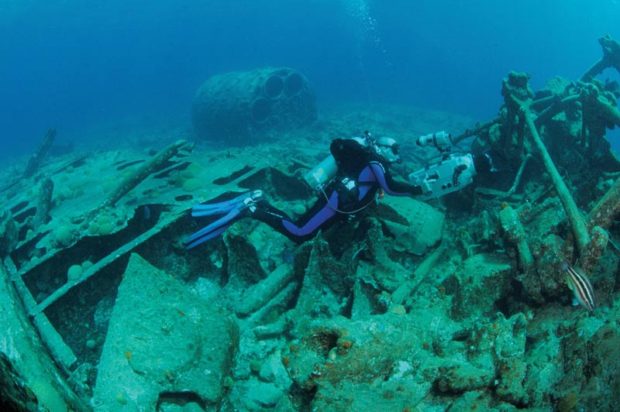The Underwater Shooter’s Skill List

By Jill Heinerth
Camera tables and rinse tanks are busy places on dive boats. Today, it seems that everyone owns a camera and is determined to get footage for their YouTube Channel or social media account. As a Monday morning quarterback who is interested in analyzing incidents, I’m noting an increasing presence of cameras in diving accidents. Carrying a camera system, even a small one, adds significantly to your task load, presenting additional challenges and risks that you might not have thought about when you were envisioning a sequence featuring a frolicking pod of Pacific White Sided Dolphins. Before you decide to become the next professional cinematographer, think about training like a professional athlete. You should dedicate yourself to work on some basic diving skills that will improve your underwater photography game plan.
The kick-off
First, consider how you will get your camera system into the water. If you are diving from a boat, you can either have the camera passed to you or jump in with it. Some systems are too large and fragile to leap from the boat with the camera system in hand. In this case, consider the sea conditions carefully. If you are jumping into a fast current, you will need to be able to quickly kick back to the boat’s swim platform and hang on until the camera is passed to you. That means rapid reactions, positive buoyancy, and a strong thrust. There may not be a moment to spare to adjust a dislodged mask or grab a free-flowing regulator. All your gear will need to be secure, well before that giant stride into the water. In the case of live-boating, you need to be alert to avoid risks posed by a spinning boat prop.
If you choose to jump with your camera in hand, be careful to avoid entanglement, catching a line with your gangly rig. As tempting as it is to clip the camera to your body with a lanyard, be careful. If you need to jettison a weight belt, it can become caught in a lanyard system. I’ve seen a strobe arm snagged in a boat line, which left a diver hanging precariously over the side by their badly sprained wrist. I don’t use a lanyard. Although my camera system may be worth tens of thousands of dollars, I would rather drop it if my safety was in jeopardy.
First down
As you begin your descent, it is easy to focus your attention on checking your camera and forget your buddy. Maintain awareness and be prepared to equalize your ears single-handedly. Most pro photographers have perfected the Frenzel Maneuver — the technique where the body of the tongue is shifted backward and upwards to the roof of your mouth to increase pressure and equalize.
Running with the ball
Refine your propulsion techniques until you can move effortlessly with your well trimmed and weighted camera rig. Neutral buoyancy hovering and helicopter turns should be elegant and easy, offering both smooth video footage and protection for the environment.
Trick plays
General spatial awareness is essential, helping you to visualize your presence in 3-D space. Once you develop your virtual “eyes in the back of your head,” you can safely move backward with gentle reverse kicking, either to fight a bit of current or ease into the right spot for your shot. Reverse kicking is not easy. Develop this skill first before trying it with a camera.
Putting it through the uprights
When you are concentrating on a shot or sequence, your eyes may be fixed to a monitor while your artistic right-brain focuses on capturing the beauty. That leaves little head space for navigational awareness. Ensure your buddy understands that there is a possibility you may become disoriented. Force yourself to look over the housing and re-orient from time to time. Use natural navigation clues by recalling a series of landmarks that will get you back to the boat and don’t be shy about using tools like a spool to offer real navigation support.
Making a game plan
Buddy skills and briefings are critical elements of safe video dives. Involve your partner in lighting, modeling, and navigational roles. Ask them to do the extra work of running reels or shooting lift bags when necessary, but be confident you can operate the same equipment if required. Practice swimming with your buddy in a way that keeps them in your peripheral vision without needing to turn around. You may want to take the lead to get to a particular location, like an octopus’s garden, but advise your buddy that they should avoid swimming behind you in your blind spot.
Surviving a fumble
At some point in your life, you will likely flood a camera or a video light, but it is no reason to panic. If you decide to abort the dive because you flooded your camera housing, be prepared to perform all the necessary decompression and/or safety stops. Your safety is more important than the gear that you carry. A large video housing can become negatively buoyant when filled with water. If it becomes unmanageable, be prepared to ditch it.
Good diving skills take time to develop and using a video camera safely and responsibly takes dedication and practice. Refine your dive skills and you will soon be dancing in the end zone with compelling well-shot underwater video.







